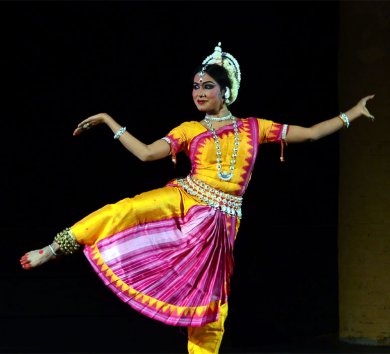
|   |

|   |
Stunning solo by Sujata Mohapatra - Nita Vidyarthi e-mail: drnitav@rediffmail.com January 28, 2015 One of the most brilliant and foremost dancers of the present generation adorned with numerous awards including the very recent Nritya Choodamani conferred by Krishna Gana Sabha, Chennai, Sujata Mohapatra, disciple and daughter-in-law of Guru Kelucharan Mohapatra enchanted the packed audience at the G.D. Birla Sabhagar, Kolkata, celebrating dance and music as a part of the Sur Festival. With Guru Ratikant Mohapatra (also a Nritya Choodamani awardee) on the mardala and other accompanists, the Odissi recital had to be special. 

Beginning with the customary pushpanjali and “trikhandi pranam” (triple salutation), the dancer presented a mangalacharan “Vishnu Vandana” (Shantakaram Bhujagashayanam) as the invocatory piece embellished with stunning sculpturesque motifs, especially the “Bhujangashayanam,” sitting grandly with the right hand in sarpashirsa mudra. The piece set to raga Gurjari Todi and triputa taal was followed by ektali, Hamsadhwani Pallavi composed in 1979 for Kumkum Mohanty by Guru Kelucharan Mohapatra with music by Pandit Bhubaneswar Mishra. The intricate and technical brilliance of the nritta developed with variations in the melodic phrase of the raga Hamsadhwani with rhythm, expanding constantly from simple to complicated steps interwoven with the rhythmic syllables, was unfolded step-by-step by the charming, lyrical and fluid quality of Sujata’s elegant execution punctuated by stylised poses from temple sculpture. Her expressive eyes and subtle smile added a creative identity to the otherwise classic composition. The concept and elucidation of “Na bheda bhakti” (nine dimensions or aspects of bhakti) was presented through the Shabari episode of the Ramcharitmanas choreographed in the “neo-classical” Odissi style developed by Guru Ratikant Mohapatra. The choreography had highly stylised movements embracing the nritya and abhinaya. The superb and evocative ekapatra sensitive abhinaya of Sujata as Rama and Shabari both rendered spontaneously with consummate ease, captivated the audience. The dancer with the striking vertical bodyline portraying the regality of Rama was as appealing as with the stoop of old Shabari. The audience was privileged to watch an exquisite demonstration of satvikabhinaya at its best. Her intense abhinaya as the old bent Shabari, soaked in bhakti, offering the partly eaten berries to her Lord Rama was overwhelming, particularly when she (Sujata as Shabari) touches Rama’s feet (Shabori barbar Prabhupadey shiro lahi - hey Ram) and attains moksha (salvation), the tender nuances captured effectively by the dancer, by the intriguing strokes of Nirmal Nayak’s violin and Soumya Ranjan Joshi’s flute. The gripping script by Pandit Nityananda Mishra was set to music by singer Rupak Kumar Paridha, the songs and shlokas rendered by the singer himself. The concluding Moksha in raag Bhairavi set to ektali, saw the dancer at her joyous best. The enjoyment of the presentation by a dancer of high calibre like Sujata with an ace mardala player and choreographer like Guru Ratikant, was an experience distinctly sharpened by the choreographic technique and its mural decoration by the highly lyrical movements of the magnificent dancer. Dr. Nita Vidyarthi is a critic of performing arts, specialising in dance, dance theatre and expressions and is a regular contributor to The Hindu, and the Statesman Kolkata in dance, vocal music and theatre. She is trained in Kathak, Bharatanatyam and Manipuri as well as vocal, semi-classical music and Rabindra Sangeet. |